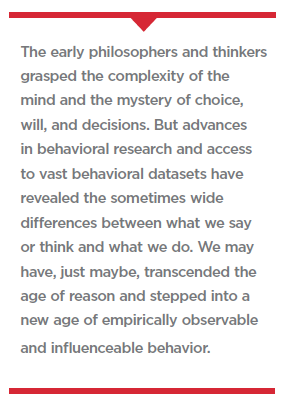Real-world evidence is mounting in support of observable customer behavior over customer-reported preference. This  empirical force is challenging the value of traditional research, buoying big data analytics, opening doors for “nudging" customers toward desired outcomes, and surprisingly, reviving conjectures by philosophers of old. The implication is an emerging application of powerful drivers of health behavior change and outcomes. Brands and practitioners who understand and embrace these ideas may well be at an unfair advantage over the next decade.
empirical force is challenging the value of traditional research, buoying big data analytics, opening doors for “nudging" customers toward desired outcomes, and surprisingly, reviving conjectures by philosophers of old. The implication is an emerging application of powerful drivers of health behavior change and outcomes. Brands and practitioners who understand and embrace these ideas may well be at an unfair advantage over the next decade.
Independent Decision Makers?
For thousands of years, philosophers have debated to what extent human beings possess “free will." Plato believed free will was determined by our ability to decipher good vs bad. Nietzsche held the opposite view, that as just another animal, albeit an advanced one, humans held no free will whatsoever. Recent studies allude to a subtler middle ground, suggesting that free will perhaps is more nuanced than we had originally believed. The implications of these studies have a profound influence on customer insights in the form of market research and big data analytics, on customer communications, and on motivating behavior change. The behavior change implication is especially important in the sphere of patient decision-making and health outcomes.
You may be familiar with Benjamin Libet’s research from the 1980s, where he discovered that decision-making in the human brain occurs at a subconscious level prior to the subject realizing that he or she has made such a decision.
Subsequent research over the last decade, including Stefan Bode’s, has shown that such decision-making at the subconscious level often occurred up to 10 seconds before a subject even consciously realized they had made a decision. Afterward, subjects would proceed to come up with a retrospective reason (justification?) as to why they made a certain decision within the experiment. However, brain scans revealed that this stated decision could not have possibly correlated with the actual reason the decision was made, much like when a patient attributes getting better to the placebo effect. Could this be one of the reasons we sometimes tell researchers one thing in our perceived self-delusion of honesty, but do something else?
The “Say" vs “Do" Gap
If accurate, the results of these studies mandate a perceptual shift in seeking, interpreting, and executing against seemingly genuine customer responses and feedback as extracted from traditional market research. If a person’s explanation for their decision-making process is mainly inaccurate and delayed, would this not seriously draw into doubt any standard market research questions? Recent examples from politics to business seem to provide casual evidence. Recall the brief but intense credibility crisis faced by polling and market research following their mostly erroneous prediction of the 2016 presidential election? These were followed by a call for better empirical behavioral predictors and may be harbingers of what is to come. Or the abandonment of surveys by Netflix, after they determined movie customers go back to watching the same mundane programs repeatedly. By the way, Netflix has stopped asking us what we want — it looks at what we do, and know. Or in the 2012 Forbes article “Why So Much Research Sucks," which discusses a large company that decided to raise its product price after thorough and sound market research, because price was listed as the least important factor for selecting the brand versus the competition’s product. Sales plummeted, and they immediately reversed course and stabilized the price back to its original cost. In other words, the  subjective data the company had acquired was inaccurate and unreliable. According to the Forbes article: “People are often incapable of articulating why they do things or how they would behave in the future. Our behavior as humans is influenced by many, many factors, most of which aren’t conscious or rational." Hey, if we all really floss as often as we tell our dentists that we do, I think the sales of floss should be higher than it is.1, 2
subjective data the company had acquired was inaccurate and unreliable. According to the Forbes article: “People are often incapable of articulating why they do things or how they would behave in the future. Our behavior as humans is influenced by many, many factors, most of which aren’t conscious or rational." Hey, if we all really floss as often as we tell our dentists that we do, I think the sales of floss should be higher than it is.1, 2
The Era of Observable Behavior
How can these issues be avoided in healthcare market research, which historically has focused on the use of subjective-based questions (interviews, questionnaires, surveys)? The emerging alternative is the increased reliance on what customers do. Marketers should focus on measuring actual behavior rather than focusing on the subjective viewpoints of respondents.
Big data is, in fact, big behavioral data, and these massive behavior datasets could also be called non-user aware feedback. They are traces of individual behavior from computers, mobile, cars, and health tracking devices that can be linked together to expand our understanding of customer or patient behavior. Advances in big data have therefore provided opportunities to harness a wide array of demographic, attitudinal, behavioral, and environmental context data. When linked and analyzed, the quality of insights revealed is quite astonishing, and certainly more reliable than observed via surveys. The recent search data project by Seth Stephens-Davidowitz, a former data scientist at Google, provides one of the starkest and quite compelling examples of the depth of customer insights and understanding obtainable from audience behavior relative to research. In his aptly named book, “Everybody Lies: Big Data, New Data, and What the Internet Can Tell Us About Who We Really Are," he covered a wide range of topics that showed stark differences between data from research compared to actual behavior revealed in our searches.
The success of many businesses and ideas, especially in the technology realm, can be linked to their appropriation of the power of empirically observable behavior. The spectacular success of YouTube, Instagram, Amazon, Google, Netflix, and Uber has elements of reliance on such data relative to research. YouTube, for example, began as an attempt at an online dating website. But its creators realized that the market for such sites was already crowded and saturated. They began measuring customer behavior and noticed that customers were more interested in finding high-quality videos online, a small portion of their early site, rather than seeking love on their platform. The rest is history. Or Instagram, which originally provided a wide array of features beyond simply photo sharing, observed that customers were much more active in the photo-sharing aspect of their site than the others, and so they focused solely on the picture-sharing side of their business. The data-driven approaches of Google, Netflix, and Amazon are so well known, I don’t have to repeat them.
These data (and empirical-behavior) driven companies are some of the biggest and fastest growing success stories of the last 15 years. Their market research, during the time of their early development, focused on measuring behavior of customers and adjusting their customer offerings accordingly.
Implications for Healthcare Marketers
So what do we healthcare marketers do? While we may not have the business models of the technology giants, nor own vast oceans of data on customer behavior like they do, we can tap into the core capabilities afforded by our understanding of the power of subliminal decision-making, our appreciation of the limitations of getting straight answers from our customers, and the feasibility of getting enough datasets on behavior (in a responsible and privacy-respecting manner, I should add).
I advocate four key takeaways;
1. Data, and lots of it.
Seek out empirically observable behavior data. We are not advocating total abandonment of research, which still provides useful information and insights. Traditional research, when conducted well, can still address a wide range of questions, especially those that behavioral datasets are not available or are inaccessible to address. But when the opportunity exists to glean insights from behavioral rather than survey data, prioritize the behavioral data analysis, and combine with research when possible.
2. Systems design.
Design tools and systems that make customer decisions easier, or that simplify making the right decision. The effect of default options or the order in which options are provided has been demonstrated to influence the choice customers make. From your applications to website designs, consider the user experience and architecture that most support your overall objective, be it “nudging" audiences to select most cost-efficient treatment options, or most effective interventions based on your understanding of their need.
3. Content.
Harness the power of emotional connections and messages. These messages appeal to the subconscious, inform the decision deep within us, and delegate the assignment of justification to our rational selves. When your content and message appeal to the subconscious, you have a better chance of achieving behavior change. But do not overdo it — as every creative talent knows, factual messages do have their time and place.
4. Personalize and experiment.
Despite our improved understanding of customer behavior from big data, we have many communication options ranging from the tactics we deploy, the messages we want to send, when we send the messages, and how often. So, recognize the fact that you may not always get it right the first time, and be open to testing and tweaking until your customers start responding and behaving in desired (and healthier) ways.
The early philosophers and thinkers grasped the complexity of the mind and the mystery of choice, will, and decisions. But advances in behavioral research and access to vast behavioral datasets have revealed the sometimes wide differences between what we say or think and what we do. We may have, just maybe, transcended the age of reason and stepped into a new age of empirically observable and influenceable behavior. Healthcare marketers have emerging tools to harness this understanding for better health behavior and outcomes.
Editor’s Notes:
1 Dooley, Roger. “Why So Much Research Sucks." Forbes, October 4th, 2012. https://www.forbes.com/sites/rogerdooley/2012/10/04/market-research/#3a55b50a7394
2 Gazzaniga, Michael. Consciousness and the Brain. March 1999, The M.R. Bauer Foundation. http://www.bio.brandeis.edu/bauer/1999/gazzaniga.html
Ogilvy CommonHealth Worldwide — a WPP Health & Wellness company — is committed to creativity and effectiveness in healthcare communications, everywhere.
For more information, visit ogilvychww.com.

















